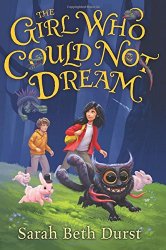
Review posted November 28, 2015.
Clarion Books, November 2015. 380 pages.
Have you ever wondered if dreamcatchers really work? And what would happen if they did?
In the world of this book, Sophie’s parents run a Dream Shop in the basement of their used book store. They collect dreams by giving dreamcatchers to people who dream, then distill those dreams into bottles with their skilled use of a dream distiller. They can see what is in the dreams by using their somnium. And then they sell the bottled dreams to special customers who know about the shop.
Sophie, however, is the girl from the title. In her twelve years of life, she’s never dreamed on her own. But there was one time she stole a dream and drank what was in a bottle – and the monster she met in the dream befriended her and came to life.
Sophie’s parents let her keep Monster, but they’ve warned her never to drink any more dreams, because there’s no telling what will come out. And if the Night Watchmen find out about her, they would kidnap her and put the shop out of business. People who make dream creatures come to life are dangerous!
But then a sinister customer who calls himself Mr. Nightmare comes to the shop and sees Monster. And the next day, she gets a note from him in her locker at school. But it’s when Sophie’s parents disappear – along with two kids from school who used dreamcatchers from the shop – that things really get sinister.
Sophie doesn’t dare call the police. The Night Watchmen can’t find out about the shop. Or about her. So it’s up to her and Monster – and a new boy from school she was going to help with nightmares – to find out if the disappearances have to do with Mr. Nightmare. Sophie may need to dream up some more help.
I confess, I tend to get hung up on the details of stories where dreams or books come to life, which definitely hurts my suspension of disbelief. I also had trouble with the bad guys’ motivation – why would they turn to crime? And is it really true that the same kids have nightmares over and over? That you could rely on certain kids to supply you with nightmares? I would have thought that some kids have bad dreams more often than others. But every night?
So readers who would be bothered by details like that might not be the best audience for the book. However, if you can accept the background of the book – it does contain imaginative details and creative problem-solving that are a whole lot of fun. The Dreamcatcher Bookshop is a cozy place, and it’s nice to read a book where the character has a loving, if a bit quirky, family.
And what if you could indeed bottle dreams? Would any of your own dreams be marketable? Which dreams would you want to catch and dispose of? And how would you fight nightmares come to life?
I love Sarah Beth Durst's teen fiction, and this book for children has her trademark imagination along with likable characters you want to spend time with.

